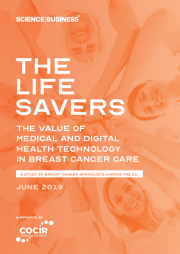A study of breast cancer specialists across the EU.
Supported by COCIR.
Get your free copy

In medical history, there are certain key advances that unequivocally have saved lives by the millions. Vaccination, antibiotics, knowledge of hygiene and lifestyle effects are among them. But one, the use of imaging and treatment in breast cancer, is a special case. Over just the past generation, hundreds of millions of women across the EU have entered routine screening programmes. And the results, confirmed by abundant research: early detection and greater awareness have saved millions of lives – cutting death rates by a third to half. These technologies are true life savers.
This report, the result of a year-long programme of interviews and survey across the EU, gathers the evidence – and asks all stakeholders how they think technologies, and how they’re applied, could improve outcomes even more. Use of digital mammography, tomosynthesis, magnetic resonance imaging, positron emission tomography and other new scanning and treatment techniques varies across countries and high investment costs limit access across countries. Fast evolution in care is driven by artificial intelligence, Big Data, personalized or targeted therapies, health apps and remote monitoring. Basic parts, such as x-ray mammography and radiotherapy, are ever-improving in effectiveness and accuracy. Others are still on the horizon. Together, they reflect the incremental but inexorable progress that has been the hallmark of medical technology over many years.
Our research focused on five diverse EU member states: the Netherlands, Sweden, Czech Republic, Germany and France. Respondents – from patients to doctors to researchers – see how screening and early-stage detection have transformed care for breast cancer; but each group has different perspectives, of course. Researchers look forward to more advances in image quality and accuracy, to guide their discoveries. Clinicians want multidisciplinary and digital support to share information, to foster collaboration – to improve the accuracy and efficiency of treatments. Patients, and their associations, see the benefit of early detection through screening programmes, but in treatment they want a more human experience – focused on the patient’s needs, fears and hopes. They think digital technologies, far from impersonalising care, could make it better – with smartphone apps, social media empowering patient networks, or remote monitoring to help rural patients.
There is a general consensus that the clinical history of patients, images and medical records should be shared, in a safe manner – avoiding inefficiency, redundancy or, worse, mistakes, in treatment. Another set of challenges: getting enough budget and skilled staff in imaging and oncology/radiotherapy, to be sure every patient gets the treatment she needs when and where she needs it. Often, even after clinical benefit is proven, policy makers and insurers are unable to organise access because of cost. Moving forward implies investment in, and agreeing on a way to value, new technologies and their reimbursement.

 A unique international forum for public research organisations and companies to connect their external engagement with strategic interests around their R&D system.
A unique international forum for public research organisations and companies to connect their external engagement with strategic interests around their R&D system.